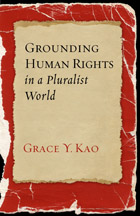 Grace Y. Kao, Grounding Human Rights in a Pluralist World
Grace Y. Kao, Grounding Human Rights in a Pluralist World
Georgetown University Press, 2011
Must human rights be grounded in a religious or metaphysical worldview in order for them to be understood and implemented globally? Or should they be developed based on broad consensus, divorced from religious grounds? These are the questions that open Grace Kao’s new book, Grounding Human Rights in a Pluralist World. Kao situates herself between these two positions, developing a rationale for human rights that is based on her retrieval of particular elements of the most prominent methods for justifying human rights approaches.
The text begins with an overview to two major approaches to these questions: maximalist and minimalist. Maximalists profess that human rights can only be grounded in, and indeed only make sense when argued from a religious worldview. Delving into the justifications for human rights provided by Michael Perry, Hans Küng, Max Stackhouse, and Nicholas Wolterstorff, Kao finds that maximalist approaches lead to the conclusion that human rights must be situated within a religious tradition or “vision” in order for them to effectively guarantee the protection of human dignity and worth. In contrast, minimalists like John Rawls, Jacques Maritain, Amartya Sen, and Martha Nussbaum profess that a defense of human rights should not be grounded in philosophical or religious presuppositions.
Kao’s retrieval of what is best from both maximalist and minimalist approaches to rights leads her to an account situated within this divide. Rejecting maximalists’ assumptions that any metaphysical grounding for human rights is religious and minimalists’ “short-circuiting of the critical edge of what human rights are supposed to mean and do,” Kao develops a grounding for human rights that is “premised on an underlying commitment to the real moral worth of all human beings.” Her justification is offered in three parts: 1) human rights must contain some account of what “human beings fundamentally are and should be able to be or do”; 2) human rights make the most sense if “we embed them within an ethically realistic framework”; and 3) combining minimalist and maximalist strategies, human rights start from an idea of human dignity that is then elaborated upon and enriched by the different cultures and traditions who subscribe to it.
Kao concludes by arguing that the human rights project is not complete, and its continued expansion to recognize the dignity and worth of all people reflects “actual social and moral progress.” She contends that some element of faith in the continued progress of humanity is required (whether it be secular or religious) in order for human rights to take root in a pluralist world.
This text would be particularly useful for those who are looking for a basic foundation to major theories of human rights justification, particularly the chapters on John Rawls’s approach to global justice (Chapter 3) and capabilities approaches to human rights (Chapter 5). In addition to providing an overview to the maximalist and minimalist justifications for rights, Kao’s analysis of the strengths and weaknesses of each approach is thorough and compelling.
Her argument for a human rights approach that straddles the maximalist-minimalist divide is intriguing. As Kao rightfully points out, human rights have evolved over time, in most part due to historical moments of crisis. They have often arisen out of concrete situations of violence or conflict. Given this, Kao argues that our understanding of human rights does not necessarily need to be grounded in abstract theoretical principles that are divorced from reality, but might instead derive from our own practices, lives, and experiences. This crucial point marks an area where her thinking engages emerging questions in human rights work. For my part, the text made me think about what a justification for human rights might look like were it to begin with how human rights are practiced in local contexts and the ways justifications for human rights emerge from local crises and events.
While Kao draws on several examples—namely, animal rights and women’s rights—as she delves into the positive and negative elements of the maximalist and minimalist approaches, the text might benefit from employing more practice-based illustrations to demonstrate the maximalist-minimalist position Kao advocates. For example, although Kao argues that differing religious traditions might bring their own particular reasoning for promoting the inherent worth of all humans, I wondered how this might work given a concrete issue like female genital cutting. Given varied understandings about what human worth is (particularly, in this case, a girl’s or a woman’s worth), how might various religious or traditional frameworks conflict in terms of the ways human rights are protected?
Kao’s text is significant in that it reminds us that the project of human rights is not finished and continues a vital conversation about how they are justified, enforced, and protected.












